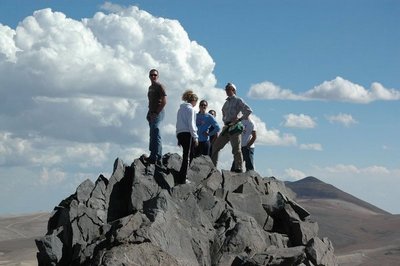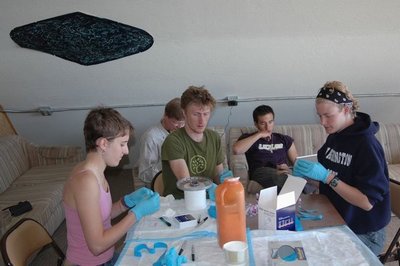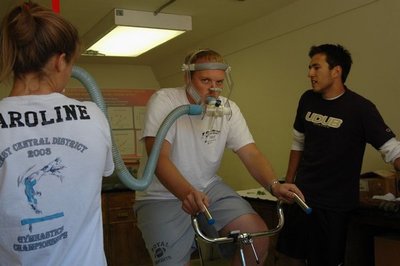January 11, 2007
A physiology lesson at 14,000 feet
Sitting in a classroom and listening to a professor talk about how the human body responds to the extreme environment of a mountaintop is one thing.
But actually experiencing it firsthand — that’s altogether different.
And that’s just what a group of students got to do last summer in one of the UW’s Exploration Seminars, a series of courses that take students away from the main campus and out into the world for experiential learning.
This course, nicknamed the Experience Physiology Project, gave 19 undergraduate students a chance to see how their bodies responded to life at more than 12,000 feet elevation.
“This seminar lets students get intimately acquainted with their physiology, only on the top of a mountain,” explained Dr. Scott Weigle, professor of medicine and a physiology instructor for the University. “We wanted to put them in a situation where their body is saying something they can’t ignore — like, ‘Hey, I can’t breathe!'”
So Weigle took this group of students to a University of California research station on White Mountain, near the California-Nevada border. The mountain is more than 14,000 feet high, making it the third-highest peak in California, but is relatively easy to climb. Hikers can scale much of White Mountain by vehicle.
But before they got that shocking introduction to a mountain environment, the students spent time with the rest of us down at sea level. Here they conducted various physiological tests on their bodies in their regular environment to establish baseline levels, before testing the effects on those measures of being at 12,000 to 14,000 feet. Students also had to draft hypotheses about how those measures would change in a high-altitude environment.
“The educational goal was to put them in a situation and have them try to understand it better through experimentation, with experiments they’d perform on themselves at the high-altitude research station,” Weigle explained.
Experiencing those changes firsthand gives them an even greater impact, he added.
“You can look in a textbook and see that a person’s blood oxygen level would decrease up there, but we wanted them to see what it actually feels like to have your blood oxygen saturation decrease by 20 percent.”
Students split into groups looking at different aspects of physiology, such as physical fitness, blood chemistry, swelling of extremities, and intellectual impairment.
The physical fitness group, for instance, hypothesized that the students would be less impaired at high altitude when running a sprint than doing a long-distance run. Sprinting is an anaerobic activity, meaning the body doesn’t use nearly as much oxygen as during an aerobic long-distance run. In the thinner air of the mountaintop, they theorized, a sprinter would be less affected by the low oxygen level than would a distance runner. After their timed sprints and distance runs at 14,000 feet, the students were able to prove that hypothesis was correct.
This process of generating hypotheses on their own and then testing them was a refreshing change for the students, according to Steve Gibbons, a UW senior who took part in the seminar. Weigle gave them a good understanding of the material, but gave them enough latitude on the experiments that they could take ownership of the work.
“Unlike most laboratory work associated with an on-campus class, our research came with no directions,” said Gibbons, who is majoring in ecology and evolutionary biology in the UW Department of Biology. “We as undergrad students had to do our own research, formulate our hypotheses and predictions, and develop our own experimental procedure to produce results. It was very liberating to have so much freedom with our work and I felt we were much more interested in the material than we would have been if we were told what to do.”
The students also performed more complex experiments, such as measuring oxygen consumption while exercising and using that to extrapolate energy expenditure.
“We wanted to try to give them an experience like what a real physiologist would do to quantify the body’s responses,” Weigle said. “I teach physiology in the College of Arts and Sciences, and that’s interesting for students. But we don’t often give them the opportunity to do real lab work with human physiology, which they got to do here.”
In addition to the real-world physiology experiments the students were able to complete, the other benefit of the program was that students were able to summit a 14,000-foot mountain. The dry, rocky environment was stunning to the students, especially those who had never even been on a mountain before.
“As we acclimated, we explored more and more area and were just blown away at all there was to see,” Gibbons said. “The landscape was sparse at best, but the views were spectacular and it was enjoyable to hike around in this unique place.”
This course and other Exploration Seminars, which are supported by the International Programs and Exchanges office of the UW, are aimed at giving students unique educational experiences in special settings — such as studying urban planning in Denmark or international relations in Shanghai, China. This course gave them a chance to learn in a mountaintop classroom, but also allowed students to study human physiology in the lab, which they might not typically do unless they continue on to medical school. Most of the students in the course are pre-med majors, but the group included people from many programs around campus.
In addition to their hands-on experience, the students will also get a chance to learn more about the clinical effects of low oxygen levels at the 2007 meeting of the International Hypoxia Symposium, in Alberta, Canada. The UW Office of Global Affairs awarded a grant to help pay for the students to attend the meeting.
Based on the success of the first Experience Physiology Project, and its popularity among the students, Weigle plans to offer the course on alternating years in the future.
Visit the Web gallery from the course at http://good-times.webshots.com/album/554483169SffWRW.





